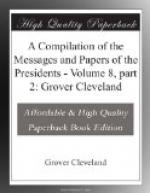With such care have the United States reserved to themselves, in all their acts down to this day, in legislating for the Territories and admitting States into the Union, the unshackled power to execute in good faith the compacts of cession made with the original States. From these facts and proceedings it plainly and certainly results—
1. That one of the fundamental principles on which the Confederation of the United States was originally based was that the waste lands of the West within their limits should be the common property of the United States.
2. That those lands were ceded to the United States by the States which claimed them, and the cessions were accepted on the express condition that they should be disposed of for the common benefit of the States, according to their respective proportions in the general charge and expenditure, and for no other purpose whatsoever.
3. That in execution of these solemn compacts the Congress of the United States did, under the Confederation, proceed to sell these lands and put the avails into the common Treasury, and under the new Constitution did repeatedly pledge them for the payment of the public debt of the United States, by which pledge each State was expected to profit in proportion to the general charge to be made upon it for that object.
These are the first principles of this whole subject, which I think can not be contested by anyone who examines the proceedings of the Revolutionary Congress, the cessions of the several States, and the acts of Congress under the new Constitution. Keeping them deeply impressed upon the mind, let us proceed to examine how far the objects of the cessions have been completed, and see whether those compacts are not still obligatory upon the United States.
The debt for which these lands were pledged by Congress may be considered as paid, and they are consequently released from that lien. But that pledge formed no part of the compacts with the States, or of the conditions upon which the cessions were made. It was a contract between new parties—between the United States and their creditors. Upon payment of the debt the compacts remain in full force, and the obligation of the United States to dispose of the lands for the common benefit is neither destroyed nor impaired. As they can not now be executed in that mode, the only legitimate question which can arise is, In what other way are these lands to be hereafter disposed of for the common benefit of the several States, “according to their respective and usual proportion in the general charge and expenditure?” The cessions of Virginia, North Carolina, and Georgia in express terms, and all the rest impliedly, not only provide thus specifically the proportion according to which each State shall profit by the proceeds of the land sales, but they proceed to declare that they shall be “faithfully and bona fide disposed of for that purpose, and for no other use or purpose whatsoever.” This is the fundamental law of the land at this moment, growing out of compacts which are older than the Constitution, and formed the corner stone on which the Union itself was erected.




